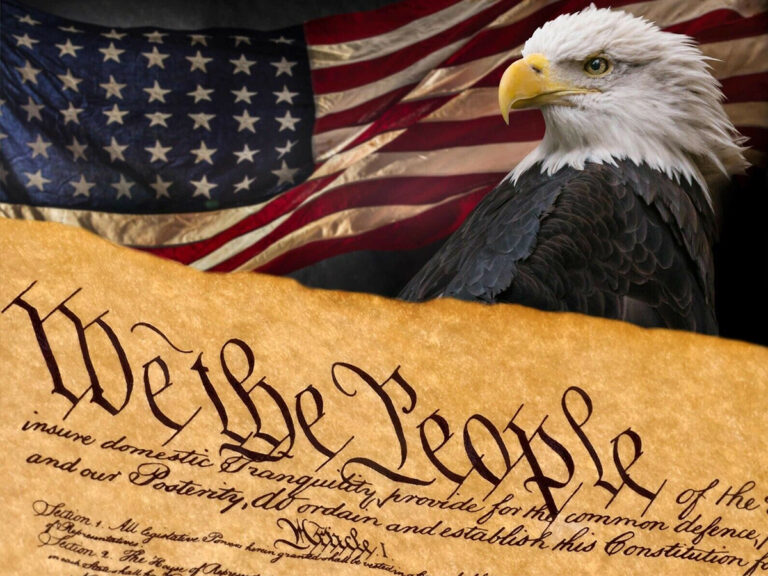
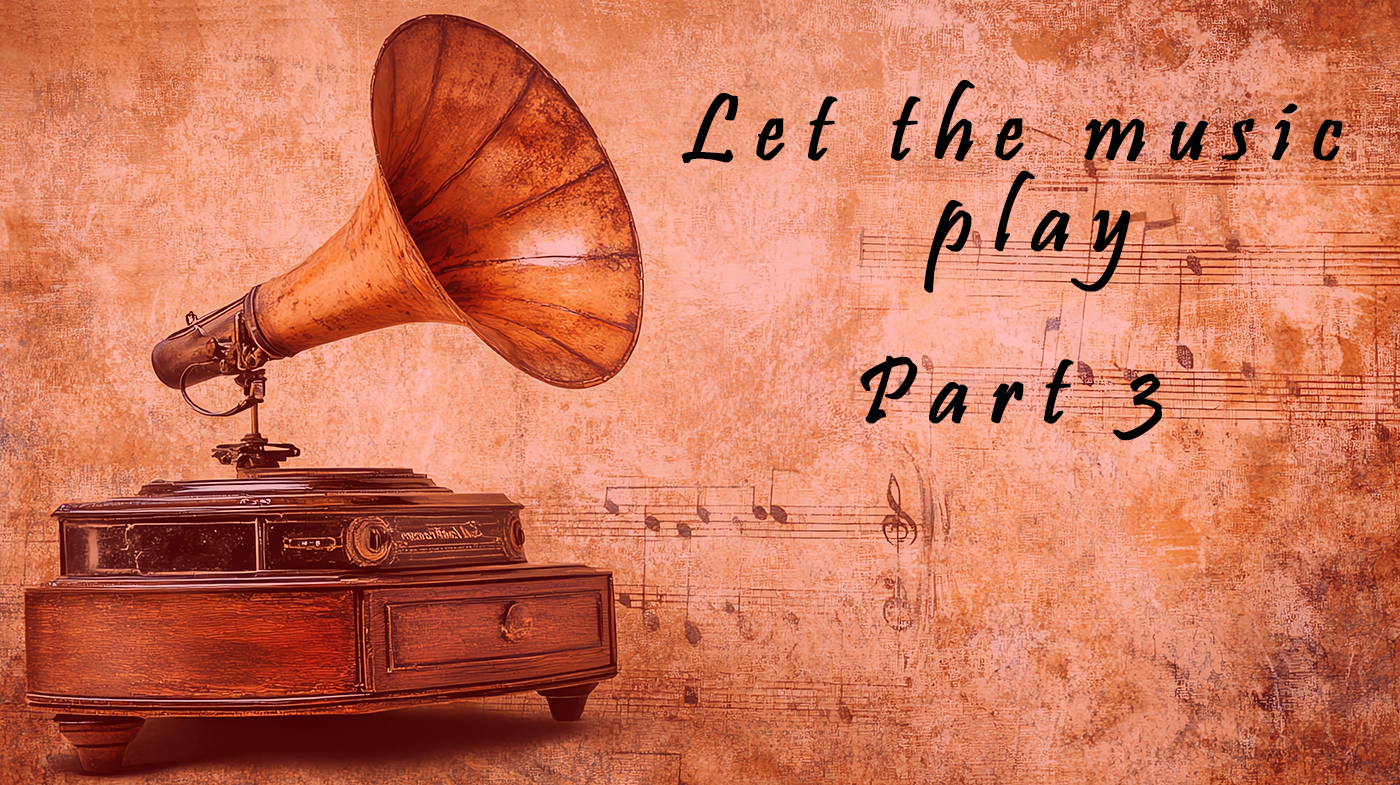
Hello Again,
I ended Part 2 of “Let the Music Play” discussing “musical variety”. If you wanted, you could click on the tab Live Performances I Attended to view a list of most of them. You may have skipped them. Good. Because that list was incomplete. I neglected to include the Musicals I had the pleasure of attending beginning with my very first Broadway Show- 42nd Street. (Ok, it was my second. I forgot about Eubie. My wife and I saw this musical as part of our honeymoon in 1979. It featured the Hines brothers, Gregory and Maurice. Amazing tap dances those two. )
Note: Links to YouTube videos are in bold red.
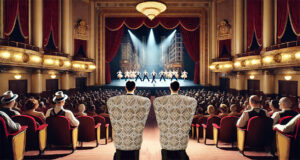
I was in NYC with my boss, Rick, sometime in the early 80’s, on business. New York’s energy was contagious and not wanting our visit to be all work and no play, we decided to see what was then Broadway’s hottest ticket-42nd Street. Naturally, every performance for the few days we were there was sold out. No worries. I had a connection. Nikki, a dear high school friend of my wife, was a dancer in the chorus line. With one phone call we were in. Not only in but because it was sold out, hello…no seats, Rick and I were treated to plush, oversized, high back chairs placed right in the aisle around row 15. At the beginning of the intermission, crew members quietly and efficiently removed our chairs to clear the aisle, returning them to their rightful place as the lights dimmed for the 2nd act. More than a few attendees gave us the “who are these guys” stare. I felt like royalty. Thank you, Nikki. 42nd Street was amazing of course. I still remember seeing Nikki and a dozen of her peers tap dancing, individually, on the top of giant dimes, about 3 feet in diameter and a foot high. 42nd Street won Tony Awards the year it opened (1980) for Best Musical and Best Choreography. It ran for nearly 3500 performances making it one of the longest running shows in Broadway History.
Curious? Click on the Tab below labeled Musicals, and 1 Opera I Saw. It is a short list but packed with memories. How about you? Seen a few musicals you may want to share? Not a fan of musicals? It’s okay. I wasn’t either, until I was. I almost hate to admit it but some years back I proclaimed “Mama Mia” the best movie ever. I had a hard time sitting in my seat during the show and danced my way back to my car. Such is the power of good, catchy tunes. Alright, enough of that.
| Musical | Venue | Year |
| Eubie | Broadway, NY | 1979 |
| 42nd Street | Broadway, NY | Early 80’s |
| Phantom of the Opera* | London | 1981 |
| Cats** | London | 1981 |
| Evita | London | 1971 |
| Lion King | Los Angeles | 1980’s |
| 1 Opera | Venue | Year |
| Cosi fan tutte | Lobero Theater, Santa Barbara | 1990’s |
| *My sunglasses were stolen from our car parked in the theater parking lot. The first and only time in my life that I was robbed.
**Roddie McDowell, the actor was sitting in our row.. It was a theater in the round. i.e. seating surrounds the stage all 360 degrees. |
||
Now that we’ve looked at one of the highs of my musical experiences, how about one of the lows.
Busted
It was Thanksgiving week, 1967. The air was crisp, the trees barren and the boys were looking to break the monotony of small-town living. The boys being me, Fragnito, Greg, Chin and Gary, the only one of us with a car. We decided to take a drive to an even smaller town, Leroy, a picturesque village actually, six miles down the road. It was early evening but given the time of year very dark. We drove up and down a few streets, shooting the breeze, cracking jokes, listening to WKBW on the radio and likely discussing our homework assignments or what more we could do to help mankind. Suddenly, we noticed a small tree near a large home on a slopping hill. It was strung with Christmas lights. What? How could this be? It was the week before Thanksgiving. Not the week after when it would be “legally” acceptable to begin decorating for Christmas. What’s next? Retail stores filled with Christmas “stuff” an entire month before the birth of Christ? Geeze. Not on our watch. Standards must be maintained. Someone had to do something to address this indignity.
It was up to us. Five Catholic boys from Notre Dame High, would step forward to protect the sanctity of Christmas while ensuring that Thanksgiving retained its own special place on the national calendar. Never the two shall meet.
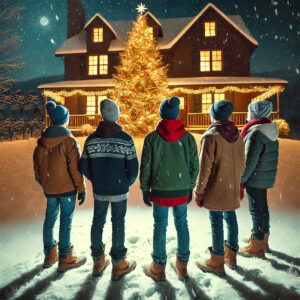
We pulled over, exited the car and made our way up the hill toward the scofflaw’s home. Now what? Well, we did what came naturally. We started singing Christmas carols of course. One to be exact. Jingle Bells. Barely, into the 2nd verse, we were startled by the sudden illumination of very bright porch lights along with a not so jolly older man yelling, “get the hell off my lawn”. He did not have to repeat himself. We were back down the hill, in the car and on our way quicker than Donner or Blitzen. Phew. No harm, no foul.
As we approached the town limits, however, we heard the siren and the flashing lights of an approaching police car. I knew we were in trouble. We followed the “arresting” officer to the Police Station. It turned out that the home owner we targeted for violating protocol was a retired Judge. Gulp. He did not share our enthusiasm and called the cops. To make matters worse the “arresting” officer informed us that the Judge had a heart attack. Holy Sh#@! We’re dead.
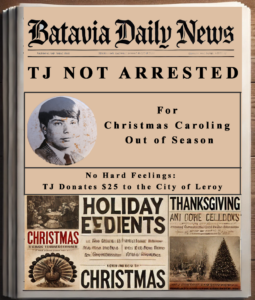 We were told that we could “settle matters” by bringing $25 in cash (each) withing 48 hours. The word “arrest” was not actually used but the words “disturbing the peace” seemed to hang in the air. What about the Judge’s breach of Christmas traditions? I did not have that kind of money, and limited time. My go to Uncle Lee (a Marine and Korean War Vet) would help me out but he was hundreds of miles away. So, I faced the inevitable, involving my parents. My dad, although displeased, did not make a fuss. My mother on the other hand was not happy. I will spare you the details but suffice it to say it was and still is one of the lowest points in my life. My mother was crushed by my behavior and let her feelings be known throughout the neighborhood. How could I…? I am confident that my own disappointment in myself matched hers in me. It would have been a public embarrassment as well, but my mom somehow managed to keep this story out of the Batavia Daily News. Our family’s reputation was spared. Upon my return to the police station the next day, I inquired as to the medical condition of the Judge following his heart attack. “Oh, that was a year ago, he’s fine now”. Grrrrr. Well then, Halleluiah. We were not the cause and I learned a few new lessons. None the least of which was to not mix the holidays. Give them their due. Which was what we had set out to do in the first place.
We were told that we could “settle matters” by bringing $25 in cash (each) withing 48 hours. The word “arrest” was not actually used but the words “disturbing the peace” seemed to hang in the air. What about the Judge’s breach of Christmas traditions? I did not have that kind of money, and limited time. My go to Uncle Lee (a Marine and Korean War Vet) would help me out but he was hundreds of miles away. So, I faced the inevitable, involving my parents. My dad, although displeased, did not make a fuss. My mother on the other hand was not happy. I will spare you the details but suffice it to say it was and still is one of the lowest points in my life. My mother was crushed by my behavior and let her feelings be known throughout the neighborhood. How could I…? I am confident that my own disappointment in myself matched hers in me. It would have been a public embarrassment as well, but my mom somehow managed to keep this story out of the Batavia Daily News. Our family’s reputation was spared. Upon my return to the police station the next day, I inquired as to the medical condition of the Judge following his heart attack. “Oh, that was a year ago, he’s fine now”. Grrrrr. Well then, Halleluiah. We were not the cause and I learned a few new lessons. None the least of which was to not mix the holidays. Give them their due. Which was what we had set out to do in the first place.
Live Music- The 1960’s and 70’s vs Today
Local bars, night clubs and small venues were central to everyone’s music experiences in the 1960’s and 70’s. They provided an intimate setting for live performances, where up and coming artists could connect directly with the audiences. Multiple music genres coexisted exposing us to jazz, blues, rock, folk and more. Small concerts were affordable, accessible and a regular part of social life.
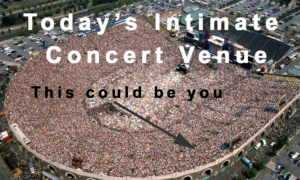
Today, the music industry is much more centralized and commercial. Large scale stadium concerts dominate because they maximize profits and broaden the artist’s reach. Fans apparently think nothing of shelling out hundreds, sometimes thousands of dollars to join tens of thousands of others at Yankee Stadium. Then of course there are the “mega festivals” like Coachella or Lollapalooza attracting hundreds of thousands of fans. As is often the case many if not most end up watching the show on jumbotron screens because the performer(s) are so far away. I have been to a few large venue concerts and find the huge screens a distraction regardless of my location relative to the stage. I must force myself to look at the performers even though they are more prominent on the big screen. Perhaps I am better off watching my favorite musicians on YouTube videos. I would of course miss the crowd’s energy but save a lot of money and time. I don’t know. Guess I’m just venting.
As you may have read, Taylor Swift recently completed her 2-year Eras Tour. Performing for over 10 million fans grossing $2 billion, dressed mostly as a majorette.
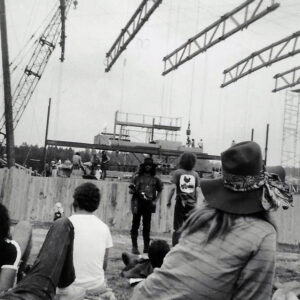
But TJ, you went to Woodstock. How is that much different than a large stadium concert? For starters tickets for the 3-day festival were $18. Six bucks a day. Woodstock was a phenomenon. A spontaneous happening no one saw coming. A confluence of events. I was just thinking about the acts that performed that weekend. Every one of the individual performers as well as the groups relied upon only their voices and instruments. Looking around today at music festivals as well as the plethora of tv talent shows like the Voice or American Idol, talent, although required, is overshadowed by theatrics. You must create a spectacle to stand out. Merely singing or playing an instrument would bore audiences to death. You need fireworks, dozens of backup dancers, fog machines, lasers, strobes, acrobatics, falling water and God knows what else. Oh yeah. Entering from the ceiling or being shot from a canon onto the stage should get you favorable ratings. Lest I forget apparently it is mandatory these days to grab your crotch… frequently. Doing so conveys confidence and allows you to re-adjust your underwear in a new, cool way. Man, oh man.
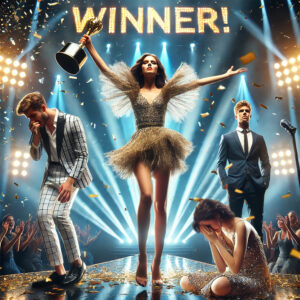
There is of course the distasteful practice of judging performers and their performances against others in an effort to determine, “the best”. First and foremost, these Talent Shows, like cooking shows, are competitions designed not merely to entertain but to make money. I know what you are going to say. Dick Clark and American Bandstand rated songs all the time in their “Rate a Record” Segment every Saturday afternoon on ABC. You remember the often-repeated classic refrain: “It’s got a good beat and it’s easy to dance to. I give it an 85”. Here is a segment from 1967 you may enjoy or possibly even remember. Click here.
The big difference by the way between American Bandstand rating songs and popular “talent” shows today, is they were rated independent of one another, not in competition with one another. I find judging art or movies or talent a bit ridiculous. Who’s better, Mozart or Bono? Picasso or Andy Warhol? Jack Nickolson or Emma Stone? By the way, why don’t they have just one generic category for best actor? Don’t get me started on G.O.A T. There is no such thing as “greatest of all time”, in anything. It’s relative and mostly subjective.
I would really like to continue talking about the music of the 50’s, 60’s and 70’s, our music. And I will, but I think a little history will give us some needed perspective. How did we get here? Let’s begin with music’s subtle beginnings during the Fred Flintstone era. Kidding.
Music’s Recent Evolution- Well, 400 Years…It’s All Relative
Up until the 20th century the only way one could experience music was through live, in-person performances. Unless you consider musical clocks and barrel organs music. These mechanical devices were developed in the late 16th century and used pinned barrels or rotating drums to play pre-programed melodies. The precursor to the player piano (1883- look ma, no hands) was the mechanical organ developed in the 17th century. They relied upon air and pipes but also played music from perforated rolls and pinned cylinders. The music world changed dramatically of course with Thomas Edison’s phonograph in 1877. More on the aftermath in a minute.
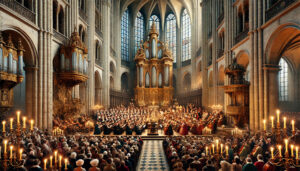
Live performances- Concert halls as we know them today were rare in the 17th century. Public concerts were evolving and most musical performances took place in churches, royal courts, noble salons (gatherings of intellectuals, artists and aristocrats…think money) and early opera houses. Audience size varied with most numbering a few hundred people. As you would imagine sacred music (organ and choral accompaniment) would pack churches and cathedrals alike. Protestant congregational singing was a big draw and could accommodate a few thousand fans. But, being packed tight on a single level, was not very pleasant and negatively affected nearly everyone’s view of the proceedings. Opera was the biggest innovation in the 17th century drawing large audiences especially across Italy and France then expanding rapidly across the continent. England saw its first public concerts during this period and they frequently included violin sonatas.
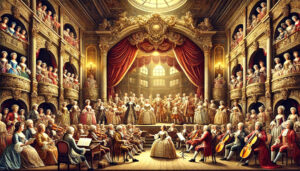
Opera continued its domination throughout the 18th century making it the golden age of opera. The spectacles created by staging, lavish costumes and dramatic story telling were a powerful draw. Not merely for the Aristocracy or upper class. Opera was a mass entertainment form that would accommodate nearly everyone. Cheap seats in the upper balconies and standing only sections ensured that the working class and commoners could enjoy the performances. Unlike today’s “quiet” opera house experience, 18th century audiences were rowdy- they talked, ate, gambled and even conducted business with one ear on Mozart’s- “The Marriage of Figaro” or perhaps Handel’s “Rinaldo”. Beethoven of course, (live and in person) was highly popular in the late 18th and 19th centuries.
The number of concert halls continued to grow as did their size. Audience capacity varied between 200 to 1500 people. The Teatro di San Carlo (Naples, 1737) – could handle 3,000 spectators.
The 19th century saw a dramatic expansion of concert halls, typically accommodating between 800 to 3500 spectators. The Royal Albert Hall in London being a standout as it could hold 7000 fans. Concert going became a very popular leisure activity. Opera morphed into Grand Opera- more elaborate, more dramatic. Verdi (Italy) and Wagner (Germany) dominated opera houses while Ballet music gained prominence. Tchaikovsky’s Swan Lake and the Nutcracker were all the rage. Symphonies by the likes of Beethoven, Brahms and Mahler expanded orchestral possibilities. Virtuoso soloists and piano music drew large audiences while touring. Liszt and Paganini performances were the rock-star events of their time. Choral music and oratorios packed concert halls across Europe with popular selections such as: Beethoven’s Missa Solemnis, Brahms’ Requiem, Mendelssohn’s oratorios.
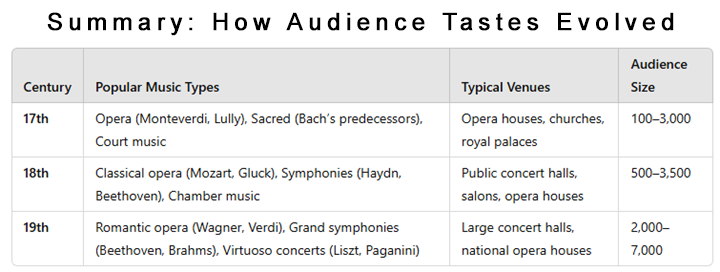
Music in the 20th Century
Fasten your seatbelt. A lot went on and I don’t want to lose you.
I realize that the first half of the 20th Century is not “our time” but great music knows no bounds. Explore a little.
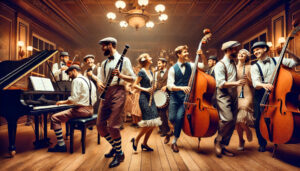
Although difficult to visualize, my grandparents were no doubt gathered around a piano on weekends (1900-1920), listening and fast stepping to Ragtime. Perhaps a Scott Joplin tune. Probably not as they were newly settled immigrants, working the land in rural New York. But many others were taking advantage of dramatic developments in music with new genres gaining popularity. The blues, originating in the deep south, within black communities began to catch on in other areas of the country. Early jazz with entertainers like a then very young Louis Armstrong or Jelly Roll Morton emerged from within New Orleans. John Philip Sousa and others brought brass bands and marching music to popularity nationwide.
The 1920’s and 30’s ushured in the Jazz Age (Swing & Dixieland) and dominated popular music up to including the Great Depression. Early Country & Western, known then as hillbilly music, featured folk ballads and string bands. Gospel music, blending spirituals with bluesy worship music became a fixture in part due to talented singers like Mahalia Jackson. Song writers like Irving Berlin and Cole Porter pioneered American Popular music also known as Tin Pan Alley, through catchy tunes for Broadway and early Hollywood films.
♫ Watch vintage Charleston (1923).
♫ Or a modern interpretation of The Charleston.
♫ If you like Jitterbug click here.
♫ Or for a Swing Dance compliation click here.
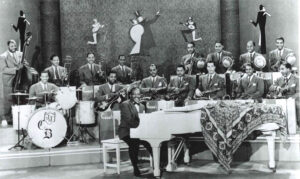
Here come the Crooners, Big Bands and Rhythm & Blues- it’s the 1940’s & 50’s. A good portion of this era although impacted greatly by WW II provided a needed escape through very danceable music provided by Glen Miller (Buggie Woogie Bugle Boy, Tommy Dorsey, Artie Shaw (Stardust) and others as part of Big Band Swing. If you liked Be-Bop, a fast paced, more complex jazz style, you were in in for a treat with Charlie Parker or Dizzy Gillespie, the guy whose cheeks expanded dramatically while playing his bent-trumpet.
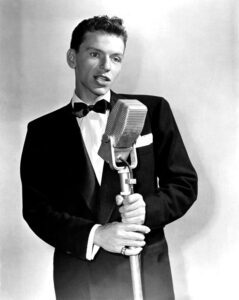
If you liked smoothed-voiced male vocalists that often performed with the big bands then Crooning Style of the 40’s and to some extent the 50’s was for you. Warm, intimate voices like “Ol Blue Eyes” also know as Nancy Sinatra’s father, Frank or The King of the Crooners, Bing Crosby, Perry Como, Mr. Relaxation and the velvety voice of Nat King Cole were among the greatest. The Crooners softened the jazz style of the big bands making it more romantic and radio friendly. In the 50’s their style of singing transitioned into pop ballads paving the way for Elvis Presley, Johnny Mathis and later soft-rock.
America is a welcoming country in many ways, music being one. There was room for growth in terms of the types of music that were flourishing in the 1940’s and 50’s. R&B or rhythm and blues was evolving from jazz and paving the way for rock & roll. Country and Honky-Tonk were modernizing through the efforts of such artists as Hank Williams and Ernest Tubb. Traditional folk music along with protest music was getting a boost in part because of the story telling abilities of performers like Pete Seeger and Woody Guthrie, Arlo’s dad.
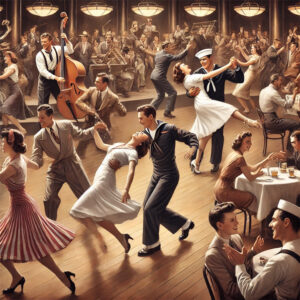 I associate 40’s with swing music. When large dance clubs and ball room dancing were central to that culture. The Savoy in Harlem could accommodate around 4000 dancers, The Aragon Ballroom in Chicago 5000 and up to 4000 at the Hollywood Palladium. There were of course many others including the Copacabana in New York City. While Frank Sinatra, Nat King Cole, Peggy Lee and glamourous showgirls graced the Copa, Ricky Ricardo a.k.a. Dezi Arnaz did not. I can only imagine the energy, the volume and the excitement of thousands of America’s greatest generation gyrating around these humongous clubs.
I associate 40’s with swing music. When large dance clubs and ball room dancing were central to that culture. The Savoy in Harlem could accommodate around 4000 dancers, The Aragon Ballroom in Chicago 5000 and up to 4000 at the Hollywood Palladium. There were of course many others including the Copacabana in New York City. While Frank Sinatra, Nat King Cole, Peggy Lee and glamourous showgirls graced the Copa, Ricky Ricardo a.k.a. Dezi Arnaz did not. I can only imagine the energy, the volume and the excitement of thousands of America’s greatest generation gyrating around these humongous clubs.
Of course, war songs and patriotic music played a big role during World War II and I would be remiss by not mentioning the USO tours best remembered for its number one host, Bob Hope. Numerous entertainers took to the stage in a show of support. Among many were familiar singers like the Andrew Sisters, Dinah Shore, Frank Sinatra, Lena Horn, Bing Crosby and Judy Garland. The USO tours entertained our troops at military bases in Europe, North Africa, the South Pacific, Alaska, the Caribbean and the Middle East.
Alternatives to Live Music: 1900-1950
When “stepping out” to experience live music was not an option, how did Americans get their musical fix? Well, it varied over the first five decades of the 20th Century, but there were options previously unheard-of or even imagined.
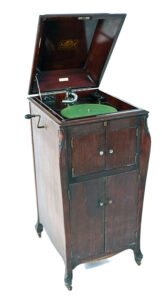
Many would of course gather around the old dependable piano to play and sing along to their favorite songs, sheet music being abundant. In the early 1900’s the Victrola, an early type of phonograph or record player, became a staple in many homes. Thick 10”- 78rpm records were the standard for records until replaced by the larger 33 1/3 rpm vinyl records in the early 1950’s. They were readily available by 1910 and very popular. My parents had a tall victrola up in our attic along with a few old 10” records. It must have belonged to my grandparents. If you have ever seen or used one you may remember that the records spin very fast and the playing arm weighed nearly a pound. The sound was fairly high pitched and the music crackled and screeched a bit. You also had to hand crank it as they were not powered by electricity.
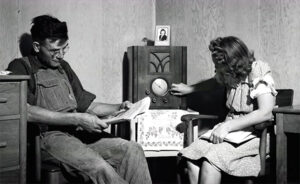
The invention of the radio revolutionized music listening in the 1920’s and 30’s and well beyond. People tuned into live broadcasts of music performances, which could include jazz, classical, and swing. The radio made it possible to hear music from all over the country. A positive unifying force, culturally.
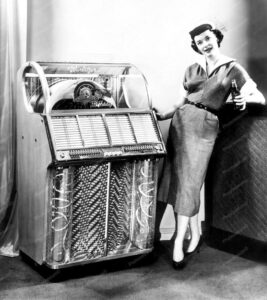
Jukeboxes were popular in public places like diners and bars enabling people to select their own songs to play. These record playing jukeboxes were key to the growth of popular music throughout the mid-20th century.
Before moving on to our half of the 20th century I must acknowledge Max Steiner and Rogers & Hammerstein. They were two of the most influential composer teams that created music for the big screens in movie theaters. You may remember Steiner for his compositions in “Gone with the Wind” and Casablanca. He wrote the music for over 300 films. R & H of course created the music for “The Sound of Music”, “Oklahoma”, “The King and I” and 8 others.
Phew. That’s a lot of history. But you ain’t seen nothing yet. The exponential growth in music genres, post 1950 is staggering. The radical changes in how we listen to music, thanks to digital, is quite striking. Still have your seatbelt?
In Part 4 of “Let the Music Play” we’ll look at the second half of the 20th century as well as the entire 21’st to date. In addition, I hope to take a look at America’s influence on world music along with Jazz and the Civil Rights Movement. This means I may run out of space for lazy musicians, and false-musical memories, forcing a Part 5. We’ll see.
Once again thank you for listening,
TJ

I left my home in the small Western New York city of Batavia in March 1977 vowing never to shovel snow again. Never say never. Settling for 38 years in what was for me the "promised land" of Santa Barbara, California. I married, helped raise a family, started a business, traveled and live a wonderful life. We spent the last 10 years of our west coast journey in the small, quiet, picturesque town of Ojai. My oldest friends call me TJ.
My wife Deborah and I moved to Colorado in 2015 to be near our daughter, her husband and 2 growing grand-boys. Add 2 bulldogs (French & English) to the mix and our hands and hearts are full. We all reside in Niwot, a small quaint town 15 minutes north of Boulder. The mighty Rocky Mountains are at our doorstep.
I am a man, son, brother, cousin, friend, husband, father, uncle, grand father, in-law and mostly retired Coloradan. You can read more about me on the About Page. If you are curious about my professional life you can visit my Career at Venture Horizon.
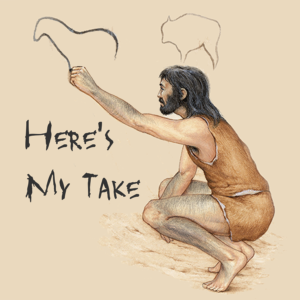
Your information is secure and private. You can cancel at any time.
Hello Lynn,
Thanks for chiming in. It is good to hear from you. Candy did what many if not most of us are too frightened to do. Torpedos be damned, I’m following my heart. It looks like she did great and had a wonderful time doing it. Meeting Ben Vereen must have been a thrill. I knew I saw you at The Russian Tea Room. Loved the Borscht.
Paul
Hey, Paul. Your dancer friend in 42nd Street made me think of my dancer friend from college, Candy Brown. Candy announced she was dropping out to become a Broadway dancer, and we all said “sure you are”. Well, a few years later I saw her in Pippin, where I went backstage and met Ben Vereen, later in Chicago (she was the murderer whose husband “ran onto my knife nine times”) in the touring company of Applause, where she sang the title number, and as a showgirl in Grind, one of Fosse’s few failures. Several times, we went to The Russian Tea Room for a late supper. Such lovely memories.